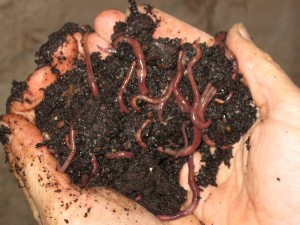Guides to Making Worm Compost
“I have had my worm farm for about 4 weeks now and they seem happy. They are consuming their food and I have no unpleasant odors coming out of my trays. I only have one concern and that is there is no wee. Please could you advise me.” ~ Eddie Horn
 Dear Eddie,
Dear Eddie,
First congratulations in successfully starting off your worm farm!
If the worms are consuming food, and no unpleasant odors are produced, these are good signs that everything is okay!
Don’t worry; I am sure you will get your worm wee soon enough!
As you start a new worm farm system, depending on what food materials you have and in what quantity, you will have different moisture levels. Although it is called worm wee, the leachate liquid is actually mostly comprised of the moisture from the food you throw in, and not the worm wee itself.
The new carbon source that you add in (the fresh newspaper / coir bedding etc) are very moisture absorbent, and will be the first to absorb any moisture produced before it has that chance to drip into your collection tray. As more food waste is added, and more moisture is produced, it will no doubt start dripping through into your collection tray.
Nutrients in Worm Leachate (Wee)
When you do start collecting your worm wee, (or more accurately called worm leachate) do take care on using it for plant watering.
Since the liquid will have passed through the worm compost, bringing many nutrients with it, the liquid will also have passed through rotting food material and may carry some unwanted things in there. Oxygenating it with an aquarium pump or something equivalent can solve most of the problems with anaerobic bacteria (bad bacteria), but do rely on your nose to detect the smell.
Generally, if it smells bad, it is bad!
If after a while you still don’t get any liquid, I will suggest monitoring the moisture levels of your worm farm system as it may be too dry, and a dry environment can easily kill off your worms!
How do you know if your worm farm is the right moisture levels?
Pick up some of the produced worm cast or soil and squeeze it together. The soil should be able to clump together with drips of water dripping out. If it does not, then it may be necessary to re-wet the worm farm by adding some water.
Be careful not too add too much water which will over log it, since this will reduce oxygen from getting into the lower levels of the worm farm system.
However, if your worm farm system contains a liquid tray (as opposed to just a worm box) excess liquid will drain through and you won’t need to worry about water logging.
Allotment Growing UK has been granted exclusive & sole permission to republish the above article for the benefit of it’s visitors who are interested in composting with worms. Originally published in the excellent free worm composting newsletter – Worm Farming Secrets
If you would like further information, an excellent step-by-step “how to” guide, or have your own unique worm composting questions, be sure to visit Worm Farming Secrets now. With over 17,000 readers, Worm Farming Secrets is quite simply the leading worldwide authority on composting with worms. Click Here Now.
More on Worm Composting & Worm Farming
Wormeries – Worm Composters in the Allotment Shop
- Introduction to Making Worm Compost
- Worm Tea & Leachate Basics
- Worm Composting With Manure
- Worm Composting – Bedding Basics
- Worm Composting Eggs & Cocoons
- Aerating Your Worm Compost
- Small Scale Indoor Worm Composting
- Flies in Worm Compost
- Mould In A Can-O-Worms Worm Farm
- Worm Composting – The Basics Of Brewing & Using Worm Tea
- Is Worm Composting Environmentally Friendly?
- Storing Worm Leachate
- Problems With The Can-O-Worms Worm Composting System
- My Worm Composting Worms Are Dying
- Worm Composting In Winter & Cold Weather



